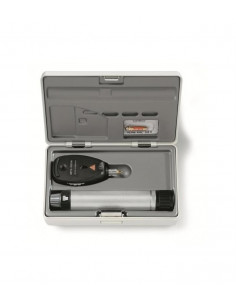
What is an ophthalmoscope?
An ophthalmoscope is a medical instrument used to examine the inside of the eye. The instrument consists of a handle with a light source and a magnifying glass at the end. The ophthalmoscope can be used to inspect the retina, optic nerve, and other parts of the eye.
An ophthalmoscope is used by doctors and medical professionals to diagnose and treat various conditions of the eye. Using the ophthalmoscope, the doctor can visually inspect the inside of the eye and identify any problems, such as glaucoma, macular degeneration, diabetic retinopathy, and other eye conditions.
Who Uses an Ophthalmoscope?
Opthalmoscopes are primarily used by ophthalmologists, optometrists, and other medical professionals who specialize in ophthalmology. The instrument is commonly used in hospitals, clinics and ophthalmology practices, but can also be used by patients at home to examine their own eyes.
Which ophthalmoscope should I choose?
There are several brands and models of ophthalmoscopes on the market, including Welch Allyn , Riester , and Heine . When choosing an ophthalmoscope, it is important to consider the quality of the lens and illumination, the durability of the instrument, and compatibility with accessories and attachments. Welch Allyn ophthalmoscopes are known for their high quality and durability, while Riester and Heine ophthalmoscopes are known for their excellent optical performance. It is also important to consider which accessories and attachments are needed for your specific needs, such as different lenses for examining different parts of the eye.
How do I use an ophthalmoscope?
Using an ophthalmoscope requires some training and experience, but can be learned quickly with some practice. Following are some basic steps for using an ophthalmoscope:
1. Make sure the patient is seated comfortably and look directly into the patient's eyes.
2. Hold the ophthalmoscope close to your eye and rotate the lens wheels to adjust the focus.
3. Turn on the lights and place the ophthalmoscope close to the patient's eye.
4. Rotate the lens wheels to inspect the retina and look for signs of eye disease.
5. Repeat the procedure for the other eye.
With some practice and experience, you can quickly master the use of an ophthalmoscope and use the instrument to improve your health. Ensure that a medical examination of the eyes is always performed by a medical professional.
Frequently Asked Questions
It is important to thoroughly clean your ophthalmoscope after each use to prevent the transfer of bacteria and prolong the life of the instrument. To do this, use a special cleaning agent for medical instruments or an alcohol solution and thoroughly clean the ophthalmoscope before storing it.
Yes, an ophthalmoscope can be used to diagnose glaucoma. Using the ophthalmoscope, the doctor can measure the pressure in the eye and identify any damage to the optic nerve that may be caused by glaucoma.
Yes, there is a difference between an adult and a pediatric ophthalmoscope. Pediatric ophthalmoscopes are often smaller and have smaller lenses to better inspect the child's eye. It is important to use the correct ophthalmoscope for the patient's age to obtain the best results.
It is not recommended that you attempt to repair your ophthalmoscope yourself if it breaks. It is better to have the instrument repaired by a qualified technician to avoid damage to the instrument and to maintain the manufacturer's warranty. If you have a problem with your medical device, please contact our customer service.







